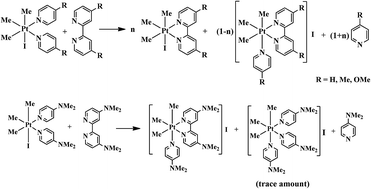A series of mononuclear trimethylplatinum(IV) complexes of bipyridine ligands, [PtMe3(L–L)I] (L–L = bipy, 4-Mebipy, 4-MeObipy and 4-Me2Nbipy) has been synthesized by the reaction of trimethylplatinum(IV) iodide with bipyridine ligands L–L in an equimolar ratio. Also, treatment of mononuclear trimethylplatinum(IV) iodide complexes of pyridine ligands, [PtMe3L2I] (L = py, 4-Mepy, 4-MeOpy and 4-Me2Npy) with the corresponding bipyridine ligands leads to the exchange of the pyridines by the bipyridine ligands, thereby resulting in the formation of the more stable chelate bipyridine complexes. The ligand-exchange reactions have been studied by 1H NMR spectroscopy. The 1H NMR spectra of a 1 : 1 mixture of mononuclear pyridine complexes [PtMe3L2I] and corresponding bipyridine ligands L–L reveal the formation of two chelate bipyridine complexes, [PtMe3(L–L)I] and [PtMe3(L–L)L]I, in solution. Speciation of the pyridine and bipyridine complexes in solution was found to be dependent on the substituent as well as on the nature of the solvent. Furthermore, crystal structures of three bipyridine complexes [PtMe3(L–L)I] (L–L = 4-Mebipy, 4-MeObipy and 4-Me2Nbipy) have also been investigated here.

